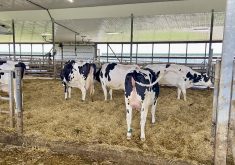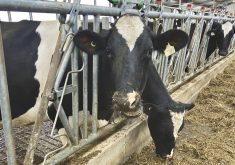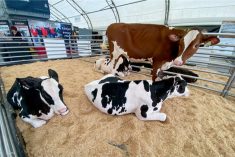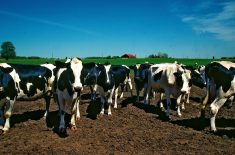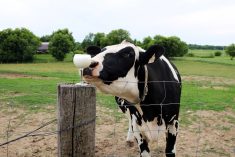Top dairy producers know their numbers, and those numbers drive faster and better ability to make decisions.
Three dairy farmers from across the country talked about how they manage their farms for top production and cow and heifer health at the recent Canadian Dairy Xpo. A common thread was using quality information to monitor their herd and create protocols that lead to greater cow health.
Why it matters: The blend price for milk in Canada continues to trend lower, with more classes of milk dedicated to competing with lower-priced imports. That means dairy farmers are more squeezed on their financial margins than they have been before. Attention to detail is more important than ever.
Daily milk weights are one of the most valued metrics on the farms of Jodi Wallace, of Ormstown, Que, Josh Ireland of Teeswater, Ont., and Joseph Holtmann of Rosser, Man.
“I’d have a tough time not having daily milk weights,” said Ireland, who, with his family, milks 230 cows, with an average production of 43 litres per cow per day. Daily milk weights require dairy farmers to have metering systems on their milking equipment, which is common. Some systems will put cows on a watch list when their production has varied by a preset amount from a previous time period’s average. That variation can mean a cow is becoming ill, or could be in heat.

Wallace uses multiple technologies to track cows on her farm, including activity monitoring, which tracks how much a cows moves during a day, and “milk weights are critical”.
Daily milk weights are important on Holtmann’s farm when monitoring fresh cows, he said.
Keeping calves healthy
Calf care is another area where the three panelists all have protocols in place.
“There’s not another job on the farm that pays better than getting colostrum into that calf,” said Ireland.
They track hours to first feeding for all calves at the Ireland’s Albadon Farms. They measure colostrum quality with a digital refractometer, and make sure they have colostrum store and on-hand, frozen in one-litre bags, double bagged.
Calves get their mother’s milk for five feedings and then receive milk replacer. The calves are fed three times per day, up to nine litres per day, until weaning.
At Holtmann’s farm, where he and his family milk 570 cows, they use purchased dehydrated colostrum. That way they know they are feeding all the calves high quality colostrum, without have to manage and test milk from cows after they calve. Their calves are fed milk replacing at an increasing volume until they get to four litres per feeding, two feedings per day.

Wallace, who is also a veterinarian, says they aim to milk all fresh cows within an hour of calving. They use an optical refractometer, a less precise, but less expensive measurement device than the digital refractometer used by the Irelands. Wallace says they try to get colostrum into calves within an hour. The calves are still up and alert after the stress of calving, but she finds they tire quickly and after the hour are resting.
Wallace, who farms with her husband Mark Anderson and his family, and milks about 100 cows, built a new calf barn several years ago. They focused on ventilation, and getting their calves off to a good start. The result is a mortality rate of zero. Calves eat free choice acidified milk through a system that circulates the milk through the barn to nipples that calves have access to all the time. The calves can drink up to 13 litres per day and she says the calves don’t get fat.
Read Also

Dissolving eartags could make pig traceability easier
A dissolving eartag for market hogs, called Clean Trace could reduce processing challenges and enable more individual management of pigs.
Fresh cows get extra attention
It’s not surprising that these producers spend time and money making sure their cows make the transition from dry cow through calving to the milking lineup successfully.
That means trying to stave off two of the major health challenges for fresh cows – ketosis and milk fever – before they happen.
All of Holtmanns cows get tested for betahydroxybutryate (BHB) every Monday. BHB is a ketone body, which at high levels is an indicator of ketosis. Ketosis occurs when a cow can’t consume enough carbohydrates to meet her energy needs. Her body then uses fat reserves to create energy, but that process also creates the unhealthy ketones.
If a cow tests high for BHB on Monday, then she will be retested on Friday and she will continue to receive glycol for energy.
Holtmann says the farm’s ketosis rate is under seven per cent, better than the goal of 20 per cent. He said the data out of the fresh cow protocol is highly valuable.
“Never overcrowd your fresh pen,” he said. He can tell when a fresh pen is overcrowded as it affects peak milk volume.
Wallace has a fresh cow protocol, where each is monitored for temperature, ketosis, mastitis and given a rectal exam. All fresh cows get glycol energy pellets and if ketotic, a glycol drench and if really a problem, an IV. She said her ketosis rate has been about eight per cent since they started managing it aggressively.
Ireland uses rumensin boluses 21 days before a cow is due to freshen. They also use X-Zelit, a product that helps cows manage their calcium levels, reducing milk fever levels.
Financial monitoring
While these three producers do an exceptional job of monitoring their calves, heifers and cows, they admit they don’t do as much to monitor the financial health of their businesses.
Ireland said they meet with their accountant, but they don’t have specific financial goals. They do monitor Return Over Feed, a popular dairy farm cost measurement, bimonthly.
“We just try to improve,” he said.
Holtmann said, “We don’t measure profitability too much,” but they are part of a group of 42 herds in Manitoba that are part of a benchmarking group, which he said has been valuable.
Wallace said their meeting with their accountant is when they look at efficiency ratios and the state of their loans. They monitor feed cost per hectolitre of milk.




